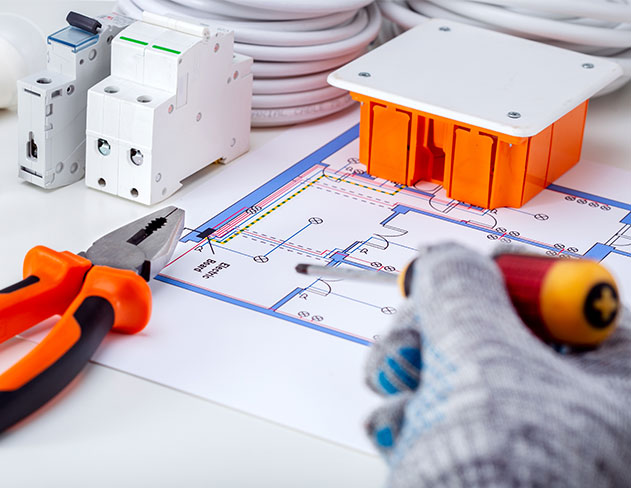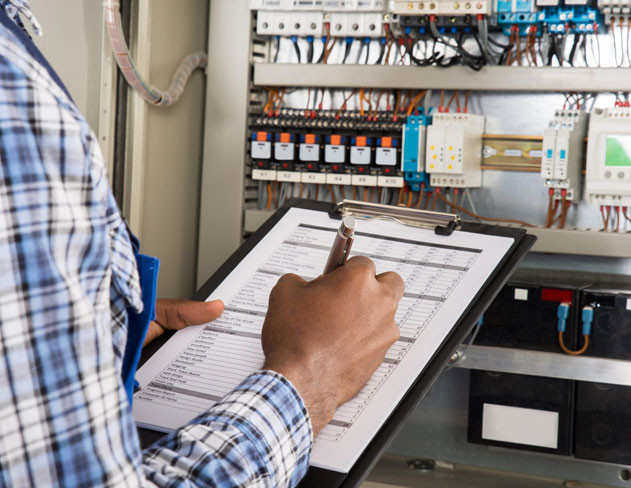The Importance of Ongoing Maintenance Between EICR Inspections
No-one should underestimate the importance of ongoing maintenance between EICR inspections.
While periodic EICRs are sometimes legally required, ongoing maintenance between inspections is equally important. EICRs provide a snapshot, but continuous vigilance is key for risk mitigation.
This article provides commercial property owners with an actionable guide for maintaining electrical safety through regular maintenance and testing between EICRs.
The Importance of Ongoing Maintenance Between EICR Inspections
Legal obligations and accident prevention make diligent electrical maintenance essential. The Electricity at Work Regulations 1989 mandate that electrical systems be maintained “to prevent, so far as is reasonably practicable, such danger.” Faults can develop unnoticed without vigilant upkeep, heightening fire and electrocution risks.
While periodic EICRs are indispensable, they are not enough alone. Preventative maintenance must be continuously performed to uphold safety.
Proactive maintenance also reduces costs from equipment damage and business disruptions caused by electrical faults. As the saying goes ‘An ounce of prevention is worth a pound of cure’ – consistent care pays dividends.
Benefits to Business Owners
Ongoing maintenance between EICRs offers several tangible benefits to business owners:
- Cost Savings: Regular inspections and preventative measures can reduce the need for expensive repairs and replacements.
- Compliance: Staying up-to-date with maintenance helps comply with legal requirements, potentially avoiding fines and legal issues.
- Risk Mitigation: Early detection of faults prevents accidents, protecting employees and customers.
- Insurance Benefits: Some insurance providers may offer discounts or incentives for well-maintained electrical systems.
- Reputation Management: A commitment to safety reflects positively on a business’s reputation and can enhance customer trust.
Regular Visual Inspections
Visual inspections by qualified personnel should occur frequently, at least monthly. All wiring and electrical components should be checked for damage, wear and tear, corrosion, overheating signs, loose connections, and other deficiencies. Meticulous inspection records aid analysis of fault progression over time. Understand the EICR procedure and what it entails with our detailed guide.
Take a walkthrough with fresh eyes to spot hazards – look up, down, behind, and inside equipment. Small issues like frayed cords can escalate if neglected. Maintain a room-by-room log with component photos to easily track inspections.
Common FAQs include appropriate inspector qualifications, label placements, and reporting procedures. Overall, well-documented, thorough visual checks are fundamental for staying ahead of developing electrical dangers. Make inspections a routine habit – it’s the first line of defence.
Collaboration with Professionals
Choosing the right professionals for ongoing maintenance is a critical decision that can significantly impact the effectiveness of your electrical safety measures.
- Choosing the Right Professionals: Look for certified and experienced electricians specialising in commercial properties. Check for qualifications like NICEIC, NAPIT, or Stroma certification, and read online reviews.
- Interview Process: Conduct interviews and ask questions about their experience with similar businesses, their approach to maintenance, and their familiarity with the latest regulations and technologies.
- Working Collaboratively: Establish clear communication and expectations with your maintenance partner. Regular meetings and updates ensure that both parties are aligned and that the maintenance plan is executed effectively.
- Ongoing Relationship: Building a long-term relationship with a trusted professional can lead to more personalised and efficient service. Regular collaboration fosters a deeper understanding of your business’s unique needs and challenges.
- Emergency Support: Ensure the professional you choose offers emergency support and can respond quickly to urgent issues.
Thermal Imaging Scans
Thermal imaging uses infrared cameras to detect hotspots and anomalies in electrical systems. Higher than normal temperatures can indicate loose connections, overloaded circuits, or faulty components at risk of failure. Hotspots are warning signs before the actual failure occurs. Thermal scanning locates hotspots so preventative steps can be taken.
We recommend annual thermal imaging scans by qualified technicians using high-resolution cameras for most commercial facilities. Critical systems may warrant more frequent inspections. Proper preparation, like load testing, helps highlight thermal patterns. Images should be expertly analysed to identify problems and determine remedial measures, like load rebalancing.
RCD Testing
Residual current devices (RCDs) are essential circuit breakers detecting electric fault currents. RCDs quickly disconnect power to prevent electrocution and fire risks. Testing RCDs monthly using the built-in test button ensures they are functioning properly and will trip when needed. Learn about EICR codes and what they mean for your electrical safety.
Our pro tip is not to assume RCDs are working – test them regularly. Malfunctioning RCDs can have fatal consequences if they fail to disconnect electricity in a fault. Exercise vigilance as RCDs can deteriorate over time. Promptly replace any defective RCDs and keep detailed testing logs, as they indicate RCD health over the long term.
Overall, staying on top of RCD testing provides invaluable protection between EICR inspections.
Creating a Maintenance Schedule
Effective electrical maintenance requires planning suited to your facility’s needs. Consult professionals to evaluate your systems, risks, and maintenance gaps. Use this assessment to create a customised schedule detailing monthly, quarterly, and annual tasks like inspections, testing, preventative maintenance, and record-keeping. Find out how often you need to get an EICR to maintain electrical compliance.
Maintenance schedules are like roadmaps – they provide direction and structure. We advise collaborating with electricians and other experts when designing schedules. Appoint qualified personnel like us to oversee tasks and log results. Review schedules regularly and update as needed – you engineer a safety culture by making maintenance systematic.
Customised Maintenance Strategies
When it comes to electrical safety, one size does not fit all. Maintenance plans should be tailored to meet your business’s specific needs and realities.
For example, an office requires very different strategies than a factory or warehouse. Conduct a thorough assessment of your equipment, usage patterns, operational workflow and industry regulations. These insights enable crafting a strategic maintenance schedule aligned to your priorities and risk profile.
Involve key internal stakeholders like facilities management in the process. They will provide valuable perspectives on where attention is most warranted based on day-to-day operations.
Remain flexible – as your business evolves, so should the maintenance plan. Regular audits help identify new problem areas or demand shifts necessitating plan adjustments.
Comprehensive documentation is the cornerstone of an effective program. Detailed records demonstrate diligence while providing data to optimise maintenance.
Empowering Staff Through Training
A customised maintenance schedule is only as good as its implementation. That’s why training staff to identify and report electrical hazards is so essential. They are your eyes and ears on the ground.
Ensure safety protocols and hazard awareness are ingrained through initial and refresher courses. Tailor the training to the different roles staff play. Maintenance teams may require more specialised instruction compared to office personnel.
Foster a culture of open communication when it comes to safety. Empower people to ask questions and raise concerns without judgement. Apply lessons proactively by having staff participate in inspections and monitoring.
Well-trained staff who understand the importance of ongoing maintenance between EICR inspections are force multipliers for electrical safety, greatly magnifying the impact of your maintenance efforts. You gain invaluable visibility between inspections by making them partners in the process.
Electrical Load Monitoring and Forecasting
Monitoring electricity use and forecasting future demand enables preventative planning as loads approach capacity. Advanced metering equipment tracks real-time consumption by zone or system. Data analytics platforms forecast scenarios using past trends and variables like weather, occupancy, and equipment changes.
Load monitoring gives you eyes on the ground – you can’t manage what you don’t measure. Review demand reports regularly and compare capacity. Plan ahead for load balancing or upgrades and identify low-use areas for possible efficiency gains. Vigilance over the long term is key to preventing overload issues.
Conclusion:The Importance Of Ongoing Maintenance Between EICR Inspections
Regular maintenance and testing between EICRs is crucial for upholding electrical safety. This article has provided actionable guidance on the importance of ongoing maintenance between EICR inspections. A guide for commercial property owners and facility managers to implement robust maintenance practices. Explore the factors that affect the cost of an EICR at Hexo Electrical Testing.

